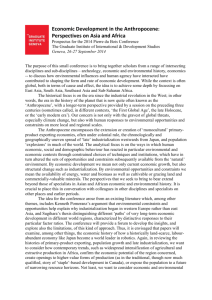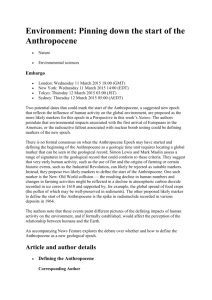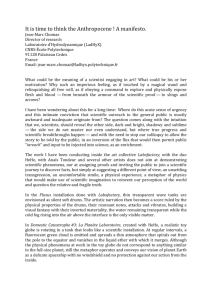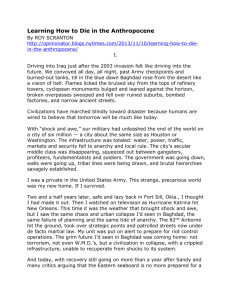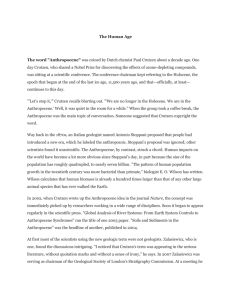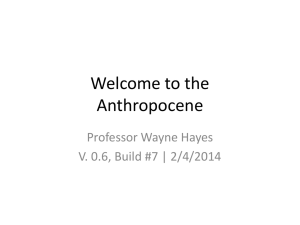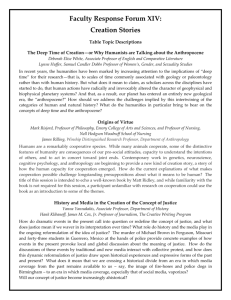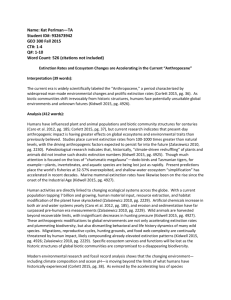Rob Nixon I want to approach the question of vulnerability from the
advertisement
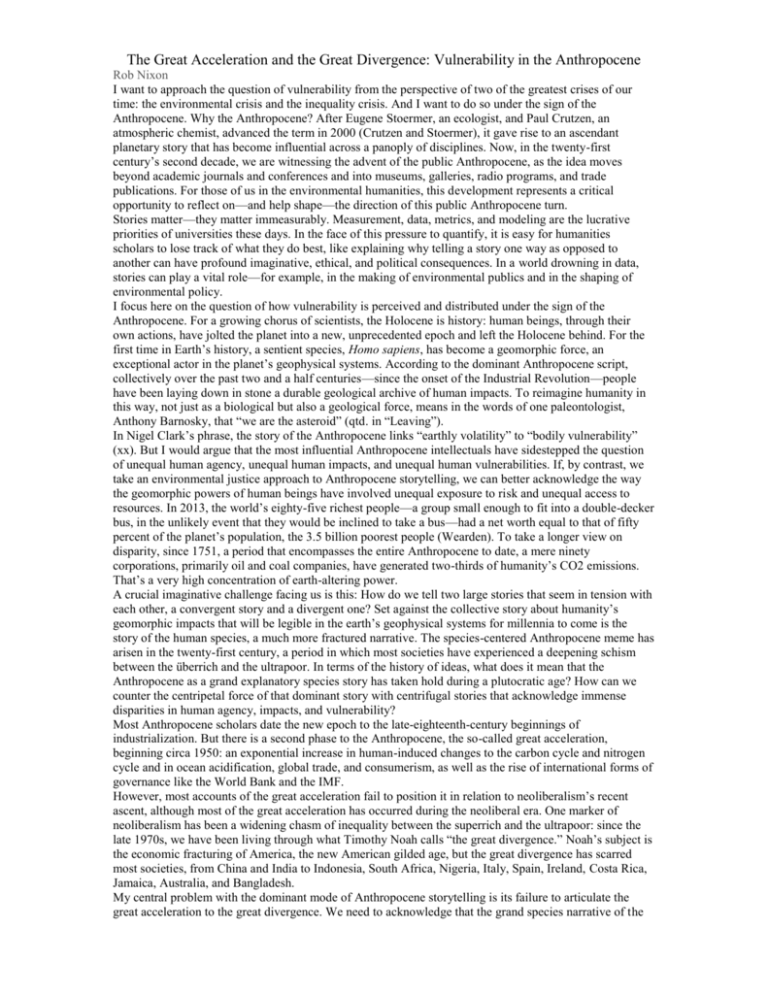
The Great Acceleration and the Great Divergence: Vulnerability in the Anthropocene Rob Nixon I want to approach the question of vulnerability from the perspective of two of the greatest crises of our time: the environmental crisis and the inequality crisis. And I want to do so under the sign of the Anthropocene. Why the Anthropocene? After Eugene Stoermer, an ecologist, and Paul Crutzen, an atmospheric chemist, advanced the term in 2000 (Crutzen and Stoermer), it gave rise to an ascendant planetary story that has become influential across a panoply of disciplines. Now, in the twenty-first century’s second decade, we are witnessing the advent of the public Anthropocene, as the idea moves beyond academic journals and conferences and into museums, galleries, radio programs, and trade publications. For those of us in the environmental humanities, this development represents a critical opportunity to reflect on—and help shape—the direction of this public Anthropocene turn. Stories matter—they matter immeasurably. Measurement, data, metrics, and modeling are the lucrative priorities of universities these days. In the face of this pressure to quantify, it is easy for humanities scholars to lose track of what they do best, like explaining why telling a story one way as opposed to another can have profound imaginative, ethical, and political consequences. In a world drowning in data, stories can play a vital role—for example, in the making of environmental publics and in the shaping of environmental policy. I focus here on the question of how vulnerability is perceived and distributed under the sign of the Anthropocene. For a growing chorus of scientists, the Holocene is history: human beings, through their own actions, have jolted the planet into a new, unprecedented epoch and left the Holocene behind. For the first time in Earth’s history, a sentient species, Homo sapiens, has become a geomorphic force, an exceptional actor in the planet’s geophysical systems. According to the dominant Anthropocene script, collectively over the past two and a half centuries—since the onset of the Industrial Revolution—people have been laying down in stone a durable geological archive of human impacts. To reimagine humanity in this way, not just as a biological but also a geological force, means in the words of one paleontologist, Anthony Barnosky, that “we are the asteroid” (qtd. in “Leaving”). In Nigel Clark’s phrase, the story of the Anthropocene links “earthly volatility” to “bodily vulnerability” (xx). But I would argue that the most influential Anthropocene intellectuals have sidestepped the question of unequal human agency, unequal human impacts, and unequal human vulnerabilities. If, by contrast, we take an environmental justice approach to Anthropocene storytelling, we can better acknowledge the way the geomorphic powers of human beings have involved unequal exposure to risk and unequal access to resources. In 2013, the world’s eighty-five richest people—a group small enough to fit into a double-decker bus, in the unlikely event that they would be inclined to take a bus—had a net worth equal to that of fifty percent of the planet’s population, the 3.5 billion poorest people (Wearden). To take a longer view on disparity, since 1751, a period that encompasses the entire Anthropocene to date, a mere ninety corporations, primarily oil and coal companies, have generated two-thirds of humanity’s CO2 emissions. That’s a very high concentration of earth-altering power. A crucial imaginative challenge facing us is this: How do we tell two large stories that seem in tension with each other, a convergent story and a divergent one? Set against the collective story about humanity’s geomorphic impacts that will be legible in the earth’s geophysical systems for millennia to come is the story of the human species, a much more fractured narrative. The species-centered Anthropocene meme has arisen in the twenty-first century, a period in which most societies have experienced a deepening schism between the überrich and the ultrapoor. In terms of the history of ideas, what does it mean that the Anthropocene as a grand explanatory species story has taken hold during a plutocratic age? How can we counter the centripetal force of that dominant story with centrifugal stories that acknowledge immense disparities in human agency, impacts, and vulnerability? Most Anthropocene scholars date the new epoch to the late-eighteenth-century beginnings of industrialization. But there is a second phase to the Anthropocene, the so-called great acceleration, beginning circa 1950: an exponential increase in human-induced changes to the carbon cycle and nitrogen cycle and in ocean acidification, global trade, and consumerism, as well as the rise of international forms of governance like the World Bank and the IMF. However, most accounts of the great acceleration fail to position it in relation to neoliberalism’s recent ascent, although most of the great acceleration has occurred during the neoliberal era. One marker of neoliberalism has been a widening chasm of inequality between the superrich and the ultrapoor: since the late 1970s, we have been living through what Timothy Noah calls “the great divergence.” Noah’s subject is the economic fracturing of America, the new American gilded age, but the great divergence has scarred most societies, from China and India to Indonesia, South Africa, Nigeria, Italy, Spain, Ireland, Costa Rica, Jamaica, Australia, and Bangladesh. My central problem with the dominant mode of Anthropocene storytelling is its failure to articulate the great acceleration to the great divergence. We need to acknowledge that the grand species narrative of the Anthropocene—this geomorphic “age of the human”—is gaining credence at a time when, in society after society, the idea of the human is breaking apart economically, as the distance between affluence and abandonment is increasing. It is time to remold the Anthropocene as a shared story about unshared resources. When we examine the geology of the human, let us also pay attention to the geopolitics of the new stratigraphy’s layered assumptions. Neoliberalism loves watery metaphors: the trickle-down effect, global flows, how a rising tide lifts all boats. But talk of a rising tide raises other specters: the coastal poor, who will never get storm-surge barriers; Pacific Islanders in the front lines of inundation; Arctic peoples, whose livelihoods are melting away—all of them exposed to the fallout from Anthropocene histories of carbon extraction and consumption in which they played virtually no part. There is a profound need for concerted action to secure a viable planetary future, and the Anthropocene idea might contribute to that action by disturbing widespread assumptions about human agency, environmental time, and planetary destiny. But let’s not pretend that we’re all in this boat together—unless the boat in question is some twenty-first-century reconstruction of the vessel that stars in Garrett Hardin’s 1974 parable on lifeboat ethics, in which the comfortable minority in the boat ponder how many of the drowning masses they can afford to take on board. As the Anthropocene story leaves academe and enters the popular domain, as we witness the current turn toward the public Anthropocene in museums and galleries and blogs, let’s make sure this story isn’t told only from the perspective of the comfortable, of those already in the boat. Otherwise, we’ll be complicit in a kind of Anthropocene lifeboat ethics that is enabled by a spurious species narrative and predicated on the privatization of survival. We need to speak out against adaptation by the rich for the rich, while humanity at large is left to flounder in waters made increasingly choppy by climate change and by the rising incidence of what insurance brokers call “extreme convective events.” In Anthropocene metrics and modeling, we are seeing considerable attention directed at what kind of stratigraphic record drowned megacities will leave. As those cities are emerging today, they are distinguished less by trickle-down effects than by the walling off of resources and by splintering urbanism (Graham and Marvin), where those whom Ivan Vladislavić calls “the well-heeled” and “the well-wheeled” withdraw into semicelestial enclaves of vertical and horizontal segregation (155). In Mumbai, Los Angeles, Mexico City, Lagos, Johannesburg, Jakarta, São Paolo, Madrid, Shanghai, and beyond, clients clamor for up-to-the-minute fortress design, new ways to wall off, as elegantly as possible, the possessors from the dispossessed. In megacities, defensive architecture rises ever higher alongside indefensible inequities. All this injustice will be legible in the Anthropocene’s stratigraphic record for millennia to come, this Dickensian tale of two cities, one built from enduring materials, the other from improvised, impermanent scraps. As I speak, another CEO takes to the air in his golden parachute, soaring above the planet of the slums. The distance between his gleaming parachute and the favela below poses a political challenge that is imaginative as well, for such distance intensifies the urgency of finding inventive, bridging testimony. As the Anthropocene goes public, we need stories that bear witness to the great divergence, stories that expose and oppose the divides segregating the plush plutocrats from the disposable people left to languish in the great acceleration’s vast shadowlands. Works Cited Clark, Nigel. Inhuman Nature: Sociable Life on a Dynamic Planet. Los Angeles: Sage, 2011. Print. Crutzen, Paul, and Eugene Stoermer. “The Anthropocene.” Global Change Newsletter 41 (2000): 17–18. Print. Graham, Steve, and Simon Marvin. Splintering Urbanism. New York: Routledge, 2001. Print. Hardin, Garrett. “Commentary: Living on a Lifeboat.” Bioscience 24.10 (1974): 561–68. Print. “Leaving Our Mark: What Will Be Left of Our Cities?” BBC News. BBC, 31 Oct. 2012. Web. 11 Mar. 2014. Noah, Timothy. The Great Divergence: America’s Growing Inequality Crisis and What We Can Do about It. New York: Bloomsbury, 2012. Print. Vladislavić, Ivan. Portrait with Keys: The City of Johannesburg Unlocked. London: Portobello, 2007. Print. Wearden, Graeme. “Oxfam: Eighty-Five Richest People as Wealthy as Poorest Half of World.” Guardian. Guardian News and Media Ltd., 20 Jan. 2014. Web. 11 Mar. 2014. <http://www.theguardian.com/business/2014/jan/20/oxfam-85-richest-people-half-of-the-world>.
